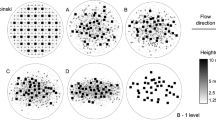Abstract
The aerodynamic behaviour of large urbanagglomerations must be represented in increasingly greaterdetail, as large-scale numerical weather prediction and airpollution dispersion models are refined. The present studyprovides detailed measurements of the flow field in regulararrays of obstacles to obtain representative data on meanflow and turbulence statistics in urban-type areas. Obstacle arrays consisting of simple cubes and flat plateroughness commonly used in boundary layer simulations wereplaced in a simulated atmospheric boundary layer flow in ahydraulic flume. The scale factor was about 1:200 based onthe obstacle height (50 mm). The results show noappreciable `constant stress' region in the internalboundary layer above the buildings, since in any finite-length test array the boundary layer is always developing.However, if the RMS turbulence components are scaled by thelocal values of the shear stress, then there seems to be auniversal scaling, with σu/u* = 2.1,σv/u* = 1.65 and σw/u* = 1.2. This greatly simplifies the parameterization of the first orderturbulence statistics in obstacle arrays. It was alsoobserved during the experiments that, compared to results inthe cube arrays, the turbulence kinetic energy and theReynolds stresses were almost doubled in the flat plateroughness arrays.
Similar content being viewed by others
References
Best, M. J.: 2000, ‘Can we Represent Urban Areas in Operational Numerical Weather Prediction Models?’, Proceedings of the AMS Third Symposium on the Urban Environment, Davis,CA, U.S.A., 14–18 August 2000.
Brown, M. J. and Williams, M. D.: 1998, ‘An Urban Canopy Parameterization for Mesoscale Meteorological Models’, Proceedings of the AMS Second Urban Environment Symposium, Albuquerque, NM, U.S.A., 2–7 November 1998.
Brown, M. J. and Spore, J.: 2000, ‘Computational Fluid Dynamics Modeling Used to Assess Meso-scale Urban Canopy Drag and Turbulence Parameterizations’, Proceedings of the AMS Third Symposium on the Urban Environment, Davis, CA, U.S.A., 14–18 August 2000.
Bottema, M.: 1997, ‘Urban roughness modelling in relation to pollutant dispersion’, Atmosph. Environ. 31, 3059–3075.
Coirier, W. J.: 2000, Development of a High Fidelity PC-based Simulator for Modeling the Atmospheric Transport and Dispersion of Nuclear, Chemical, Biological and Radiological Substances in Urban Areas, CFD Research Corporation Final Report, Huntsville, AL, U.S.A., 56 pp.
Grimmond, C. S. B. and Oke, T. R.: 1999, ‘Aerodynamic properties of urban areas derived from analysis of surface form’, J. Appl. Meteorol. 38, 1262–1292.
Hanna, S. R. and Britter, R. E.: 2001, Wind Flow and Vapor Cloud Dispersion at Industrial and Urban Sites, Draft Manual for American Institute of Chemical Engineers (AIChE) Center for Chemical Process Safety (CCPS), 136 pp.
Hosker, R. P.: 1984, ‘Flow and diffusion near obstacles’, in D. Randerson (ed.), Atmospheric Science and Power Production, U.S. Dept. of Energy Report No. TIC-27601, pp. 241–326.
Lettau, H.: 1969, ‘Note on aerodynamic roughness-parameter estimation on the basis of roughness-element description’, J. Appl. Meteorol. 8, 828–832.
Macdonald, R. W., Griffiths, R. F. and Hall, D. J.: 1998, ‘An improved method for estimation of surface roughness of obstacle arrays’, Atmosph. Environ. 32, 1857–1864.
Macdonald, R. W., Carter, S. and Slawson, P. R.: 2000, ‘Measurements of Mean Velocity and Turbulence Statistics in Simple Obstacle Arrays at 1:200 Scale’, University of Waterloo, Thermal Fluids Report 2000–1, Waterloo, ON, Canada, 130 pp.
Martilli, A., Clappier, A. and Rotach, M. W.: 2000, ‘A Parameterization of Urban Effects for Meso-scale Models’, Proceedings of the AMS Third Symposium on the Urban Environment, Davis,CA, U.S.A., 14–18 August 2000.
Meroney, R. M.: 1982, ‘Turbulent diffusion near buildings’, in E. J. Plate (ed.), Engineering Meteorology, Elsevier Scientific, Amsterdam, pp. 481–526.
Oke, T. R.: 1987, Boundary Layer Climates, Routledge Publishers, London.
Panofsky, H. A. and Dutton, J. A.: 1984, Atmospheric Turbulence, John Wiley & Sons, New York,p. 160.
Raithby, G. D., Stubley, G. D. and Taylor, P. A.: 1987, ‘The Askervein Hill project: A finite control volume prediction of three-dimensional flows over the hill’, Bound.-Layer Meteorol. 26, 247–267.
Roth, M.: 2000, ‘Review of atmospheric turbulence over cities’, Q. J. R. Meteorol. Soc. 126, 941–990.
Wieringa, J.: 1993, ‘Representative roughness parameters for homogeneous terrain’, Bound.-Layer Meteorol. 63, 323–363.
Author information
Authors and Affiliations
Corresponding author
Rights and permissions
About this article
Cite this article
Macdonald, R.W., Carter Schofield, S. & Slawson, P.R. Physical Modelling of Urban Roughness using Arrays of Regular Roughness Elements. Water, Air, & Soil Pollution: Focus 2, 541–554 (2002). https://doi.org/10.1023/A:1021392914279
Issue Date:
DOI: https://doi.org/10.1023/A:1021392914279




